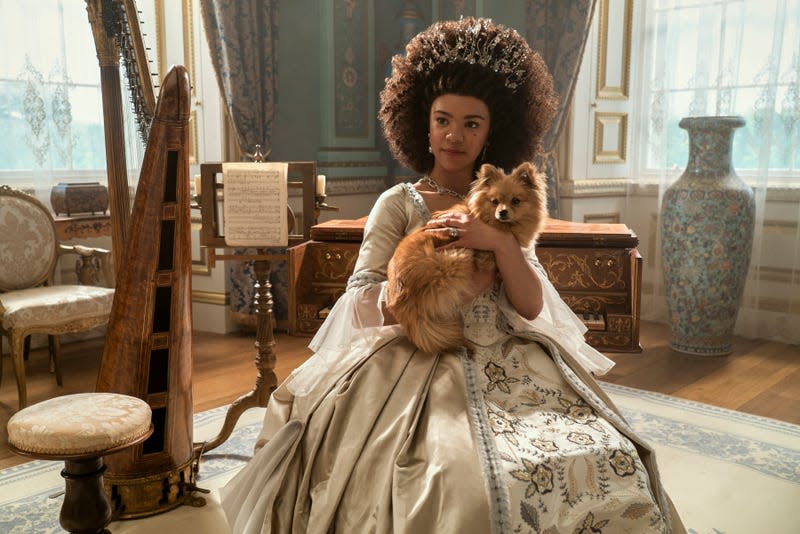Queen Charlotte Is Bridgerton at Its Blackest—and Best

- Oops!Something went wrong.Please try again later.
First things first: Queen Charlotte: A Bridgerton Story is absolutely a one-sitting binge. It is the Lay’s Potato Chips of TV shows: You cannot have just one. Seriously, prepare yourself because once you start that first episode, that’s gonna be the rest of your day. The good news is it’s only six episodes, so you’ll still have part of the day left when you’re done. And just to be clear, it’s totally worth it. Like its predecessor, Queen Charlotte brilliantly uses its Regency-era setting to make very modern commentary. Specifically when it comes to the individuality, agency and respect of women.
On Bridgerton, we know Golda Rosheuvel’s sharp-tongued queen as someone who is very sure of her place in the world and the importance of her responsibilities. This is the story of how she discovered that strength. In case you’re wondering, you don’t need to know Bridgerton to enjoy Queen Charlotte, but it certainly helps. This isn’t a universe with a complex mythology to follow, so you can just jump in and have fun. The prequel to the Netflix hit chronicles the love story between young Charlotte and George, while scenes from the palace feature Rosheuvel’s queen desperately trying to whip her children into royal shape. Charlotte is a force of nature, so we were expecting an equally vibrant portrayal in her younger version. India Amarteifio absolutely shines as a young woman who is thrust into a strange world and expected to immediately adapt. Of course, no one has ever asked if this is the life she wants for herself. Her life is planned out by men who do not care about her wants or needs. Amarteifio expertly blends glimpses of the spitfire we know with a woman trapped in a gilded cage from which there is no escape.
Read more
Aside from Halle Bailey, Here Are Other Black Disney Actors and Characters We Love [Update]
Megan Thee Stallion Becomes 1st Black Woman to Land Forbes 30 Under 30 Cover
15 Priceless Black Twitter Moments Worth Remembering [Updated]
Queen Charlotte: A Bridgerton Story | Official Trailer | Netflix
Where the series shines is in its handling of how this royal world treats race. Charlotte’s Blackness is a constant bone of contention for her mother-in-law, Princess Augusta, who will now be known as Regency Karen. In public, she pretends like everyone is fine with the new queen’s race, while privately hitting Charlotte with a never-ending stream of microaggressions. She’s clearly threatened by her daughter-in-law’s beauty and intelligence, which means she must do whatever she can to hang on to her power. That story is extremely familiar to a lot of Black women.
Having a Black queen means more Black citizens get to enter royal society–though, their good fortune definitely comes with strings attached. Arsema Thomas’ young Lady Agatha Danbury is fighting the same battle for representation that Charlotte is, making them natural allies and friends. They may be dressed in elaborate gowns and jewels, but their story is very much a modern one of acceptance, representation and dignity.
Even with all these modern issues in the mix, at its core, Queen Charlotte is a love story. The sparks between George and Charlotte are evident from the moment they meet. As they struggle to deal with his mental health, they slowly move from star-crossed lovers to a couple who are clearly meant for one another. And yes, the signature Bridgerton steaminess is on full display throughout their ups and downs. Amarteifio and Corey Mylchreest are the living embodiment of bodice-ripping chemistry. Even when they can’t stand one another, Charlotte and George cannot keep their hands off each other.
The prequel takes all the best pieces of Bridgerton and blends them into a captivating romance with a modern-day message. If you haven’t been able to get into Netflix’s Regency drama, I suggest you give it another shot with Queen Charlotte, because these characters command you to get obsessed with their stories. This is the show binge-watching was made for.
Queen Charlotte: A Bridgerton Story is available to stream on Netflix.
More from The Root
A Supersized List of March 2023 Books by Black Authors We Can't Wait to Read
19 Political Karens Caught in Their Own Lies, Nonsense and Racism
Sign up for The Root's Newsletter. For the latest news, Facebook, Twitter and Instagram.

